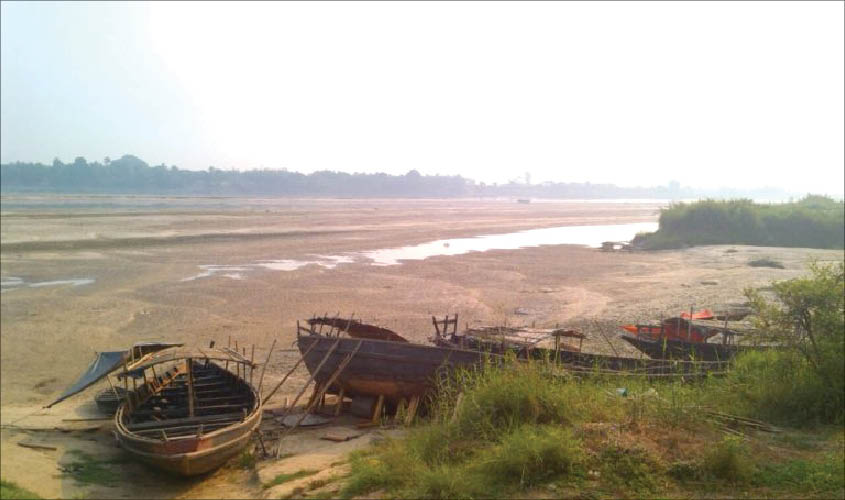Study forecasts that in the absence of interventions, groundwater contribution to the river’s water flow would continue diminishing in the summer for the next 30 years.
Millions of people residing in the lower reaches of the Ganga basin may face food shortage in the next three decades if the much revered river continues to lose water due to factors that include unsustainable groundwater extraction, a study has claimed.
Researchers associated with the study added that low river flows could also have implications for achieving the United Nations’ Sustainable Development Goals (SDGs).
But experts, not associated with the study, also pointed to the combined blow of surface and groundwater misuse that has beleaguered the Ganga river basin, sheltering around 10% of the global population. Agricultural inefficiency is a chink in the chain, they say, when it comes to sustainable water use.
The modelling study forecasts that in the absence of interventions, groundwater contribution to the river’s water flow would continue diminishing in the summer for the next 30 years.
The analysis was conducted by Abhijit Mukherjee at the Indian Institute of Technology, Kharagpur, Soumendra Nath Bhanja (formerly at IIT Kharagpur) and Yoshihide Wada from Austria’s IIASA (International Institute for Applied Systems Analysis) on the stretch of the river from Varanasi to the Bay of Bengal.
“The impacts of groundwater depletion on Ganga river flows are very complex. However, our study found that there is significant concern that ongoing groundwater pumping over the basin is unsustainable, leading to not only lowering groundwater levels but also reduction in river flows during summer time,” Wada told Mongabay-India.
This problem is more serious downstream of the Ganga river, Wada said.
Mukherjee, lead author of the study, said: “So far, in the last three decades we have seen the groundwater input to the river decline by 50% during summer. This decline could go up to 75% compared to the scenario in the 1970s in the summer months.”
Although the modelling study doesn’t factor in climate change impacts, the authors argue that if they were to do so, the situation could be worse than predicted.
The Ganga’s 2,525 km watercourse is sustained by rainfall in the hinterlands of the Ganga basin, Himalayan glacial melt as also groundwater discharge. In summer (non-monsoon months), this groundwater contribution (baseflow) to the river can be 30% in some sections and can even swell up to 60% to 70%, said Mukherjee.
“The combination of groundwater (around 70%) and river water (30%) availability actually runs the farming system that yields the food crops,” Mukherjee said.
The researchers assess that at present, surface water irrigation for cropping accounts for 27% of the total irrigation in the study area.
Hence, the dwindling of the Ganga would also severely affect water available for surface water irrigation, with potential decline in food production in the future.
“Our prediction shows that about 115 million people can be impacted due to insufficient food availability in the next few decades. In a status-quo scenario, this reduction would enhance in the future and there is a possibility that there would be reverse flow of the river water to groundwater. This is called stream flow capture,” Mukherjee said.
Apart from ongoing reduction in summer river flows heightening vulnerability of regional food production and water supply policy, Wada observed that low river flows also influence dilution of water pollution in the Ganga river, which is one of most contaminated transboundary rivers worldwide.
This is a “huge concern” for regional water supply and sanitation, he said, adding the issue could have implications for achieving United Nations’ Sustainable Development Goals (SDGs) targets.
“South Asian countries are working towards the United Nations Sustainable Development Goals (SDGs) which aim towards improving water sanitation and reducing water scarcity, but decreasing summer river flows and increasing groundwater depletion will make only more difficult for regional policy makers to achieve the targets by 2030,” Wada elaborated.
The researchers also observed that low river flows influence dilution of water pollution in the Ganga river, which is one of most contaminated transboundary rivers worldwide.
“The lower the river flow, the more concentrated the pollutants become, making it difficult to wash them out,” Mukherjee remarked.
Wada batted for more co-operation between India and Bangladesh, where the Ganga eventually flows, in regional water resources allocation.
“Local excessive groundwater pumping over two countries is affecting the river flows of the entire basin. Regional policy makers from the two countries can cooperate for better monitoring and regulation of groundwater pumping and water use at larger,” Wada said.
He noted that it is vital to understand that both upstream and downstream regions need to share the burden of better water allocation policy. “Two countries need to work very closely to establish how to improve the situation. Water scarcity will
get only worse under climate change, if the situation continues,” Wada reiterated.
IANS. In arrangement with Mongabay.com, a source for environmental news reporting and analysis. The views expressed in the article are those of Mongabay.com

